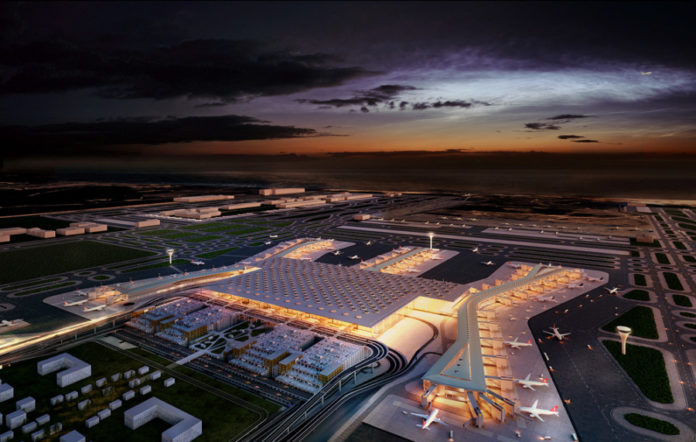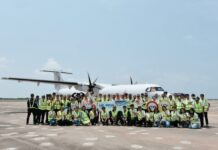

Istanbul New Airport (INA) is set to open in the fourth quarter of 2018 and the gateway is set to be one of the globe’s ‘megahubs’ and help grow freight into and out of Istanbul.
The operator is the IGA Airport Operation and Air Cargo Week spoke to chief commercial officer, Soner Akkurt (pictured below) about how the project is coming along and its freight plans.
Justin Burns, ACW: How close to completion is construction work?
Akkurt: 64.5 per cent of the construction for the first hase of INA has been completed. 31,000 people currently work on the construction site, who make sure that INA will open on time.
Justin Burns, ACW: When will it open?
Akkurt: The airport will open on 29 October, 2018 (in the fourth quarter).
Justin Burns, ACW: How important is cargo?
Akkurt: Cargo is set to play a central role in the development of INA. IGA is constructing a huge Cargo City beyond calling it a cargo terminal. The airport will have a space for ground handling services of 150,000 sqm and space of 1.4 million sqm for cargo services, which includes several facilities serving cargo businesses.
There is available space for further expansion in the Cargo City. Moreover, IGA will be including an extra cargo area in parallel with the construction of the second terminal. The ultimate area will consolidate İstanbul New Airport as an important cargo hub.
Justin Burns, ACW: How will INA boost air cargo in Istanbul and Turkey?
Akkurt: Turkey is becoming an ever-more crucial centre for air cargo. INA will make Istanbul the new centre of international transportation through its Cargo City.
The existing airports in Turkey are heavily congested and that creates a huge cost for the country. Turkey has been very successful in establishing Istanbul as a hub for passenger flights. But the lack of slots for cargo planes has prevented the same to happen in terms of cargo. Therefore, the new airport is absolutely needed and especially the logistics industry can strongly benefit from that.
Justin Burns, ACW: How much cargo will be handled?
Akkurt: In the first phase of construction, IGA plans to build a cargo/logistics centre over an area of 1.4 million square metres and expand the area to 1.6 million square metres in later phases.
In the first 12 months, the annual cargo forecast to be handled is around 1.45 million tonnes a year. In 2025, our forecast for cargo handled at the İNA is around 2.40 million tonnes. After all phases are completed, the cargo capacity will be five million tonnes a year.
Justin Burns, ACW: What freighter operators will be servicing INA?
Akkurt: Turkish Cargo and other Turkish operators like MNG, ULS etc. will definitely be servicing INA. In addition, leading freighter industry companies will be serving İNA.
Justin Burns, ACW: Are you looking to add freighter carriers to ones servicing Ataturk?
Akkurt: Having no any limitations on landing slots and night curfew, and available space and very challenging airport cargo and handling charges make the new airport one of the best cargo hubs. And surely, this will attract many other freighter operators. In addition, Turkish Airlines will also help other freighter operators to have better market penetration.
Justin Burns, ACW: Do you see INA becoming an important transit hub?
Akkurt: The airport will make Turkey one of the most important transit centres in the world and will turn over a new leaf in the Turkish aviation sector.
The geographical location of Istanbul has a great advantage for transit flights between Europe, the Middle East, Asia and Africa. It makes INA an excellent hub for transit passengers. And there is indeed a large number of transit passengers. That is why Turkish Airlines has already increased its activities.
Justin Burns, ACW: Is the aim to rival and take business away from the likes of Dubai?
Akkurt: No, definitely not because INA will follow its own strategy. Nevertheless, it is already foreseeable the new airport will provide global routes, reduce flight times and offer a high flexibility to use a variety of aircraft of diverse capacity.
Justin Burns, ACW: How entwined are the future growth of Turkish Airlines and INA?
Akkurt: It is already clear that Turkish Airlines will be one of the most important drivers in INA. As one of the key stakeholders, Turkish Airlines is very happy that the new airport will be their new main hub without any limitations. Due to this good starting situation, Turkish Airlines will pursue to grow and will have a positive effect on INA.
Justin Burns, ACW: What will happen to Istanbul Ataturk Airport?
Akkurt: INA will be the main airport when it will be opened next year. The capacities of Ataturk are not sufficient anymore, that’s why it will be replaced by INA. After the opening of the new airport, Ataturk will be utilised as an airport for general aviation and training. It will be also used as an exhibition hall.











